|
|
||||
|
Published by : PROFESSIONAL MEDICAL PUBLICATIONS |
||||
|
ISSN 1681-715X |
||||
|
||||
|
- |
||||
|
ORIGINAL ARTICLE |
||||
|
- |
||||
|
Volume 24 |
July - September 2008 |
Number 4 |
||
|
|
||||
|
|
||||
|
|
||||
|
Published by : PROFESSIONAL MEDICAL PUBLICATIONS |
||||
|
ISSN 1681-715X |
||||
|
||||
|
- |
||||
|
ORIGINAL ARTICLE |
||||
|
- |
||||
|
Volume 24 |
July - September 2008 |
Number 4 |
||
|
|
||||
|
|
||||
The effect of excessive noise exposure on the
hearing thresholds of aviation workers in Karachi
Imtiaz Ather Siddiqui1, Riaz Ahmed Siddiqui2
ABSTRACT
Objectives: The purposes of this study on Aviation Workers were to (a) determine the prevalence of Noise induced hearing loss (NIHL) in aviation workers (b) suggest measures for its prevention.
Methodology: This cross sectional epidemiological study was conducted with noise exposed and non noise exposed matching variables of adult age group, full time (24 hours), male workers at a large metropolitan airport of Karachi, Pakistan (Noise exposed group), villagers living in the outskirts of Karachi who had their work place and residence within the village (non noise exposed group). The three measures used were Hearing Questionnaire, Audiological assessment and a record review of base line hearing test (pure tone audiogram) and noise levels at locations of work and residence lived i.e. round the clock noise exposure. Subjects with other causes of hearing impairment like, otitis media, post high grade fever, metabolic disorders and history of ototoxicity were excluded from the study.
Results: A significant difference in prevalence of hearing loss (more than 30db) between the noise exposed and non noise exposed group (P <0.5) was noted.
Conclusion: Aggressive hearing conservation measures are required for these aviation workers; they are like (a) Availability of HPD’s (b) Ban on "Non Certified" aircraft operations as specified by ICAO Chapter 3, Annex-16.
KEY WORDS:
Noise, Noise Pollution, Sensory Neural Hearing Loss (SNHL), Aviation, Aviation Noise, Aviation workers.Pak J Med Sci July - September 2008 Vol. 24 No. 4 525-530
How to cite this article:
Siddiqui IA, Siddiqui RA. The effect of excessive noise exposure on the hearing thresholds of aviation workers in Karachi. Pak J Med Sci 2008;24(4):525-30.
1. Imtiaz Ather Siddiqui,
2. Riaz Ahmed Siddiqui,
1-2: Department of Ear, Nose,
Throat & Head and Neck Surgery,
Jinnah Postgraduate Medical Centre,
Karachi – Pakistan.
Correspondence
Imtiaz Ather Siddiqui,
Email: siddykee@yahoo.com
* Received for Publication: November 13, 2007
* Accepted: June 18, 2008
INTRODUCTION
Noise is the third environmental pollution agent after air and water. We are currently reaping the rewards of unwanted increase in noise in an epidemic of hearing loss, which is incurable, but surely preventable.
1 Noise from any source is detrimental to hearing and its association with work is the main cause of noise induced hearing loss (NIHL). Noise induced degenerative pattern in human ear exhibits a characteristics "Knife Sharp" demarcation between the damaged and undamaged ear. In nature sound seldom exceeds 80 dB.2 Industrial noise pollution produces louder noise which tends to last much longer. These include aircraft noise, noise caused by construction equipment and riveting tools and from 50% to 60% of all industrial workers are exposed to 85 or more decibels for eight hours a day i.e. 25% of their working life.3 The part of the hearing range that is damaged in early stage is at 4000 Hz. This is one of the important frequencies for the appreciation of the consonants of speech. Tinnitus may occur at this or other frequencies of hearing impairment.If the exposure is prolonged then frequency lower than 4000Hz will be involved i.e. 3000Hz then 2000Hz and finally 1000Hz. Intensive noise leads to total destruction of the organ of corti, especially in the upper basal turn.
4 in regions where organ of corti is completely destroyed, the cochlear neurons undergo a slow progressive retrograde degeneration over a period of months, resulting in an almost 90% loss of cochlear neurons including ganglion cells with in the spiral ganglion.5Purpose of Study:
The occupational risk of NIHL at workplace for workers exposed to high levels of noise is well established. This has been a matter of concern for industrial world although this has yet to be recognized in Pakistan. No real effort has yet been made in this regard by the authorities, employers and otologists. Noise generated by aircraft and its effect on aviation workers, who are not protected for noise, has lead to hearing loss.6 The literature is sparse in describing a relationship between occupational noise exposures and hearing loss among airport workers. In Pakistan no literature exists which describe effect of occupational noise exposure and hearing loss to aviation workers at commercial airports. Karachi is the commercial Capital of Pakistan. There are 175 take off’s and landings in 24 hours (7.29 landings and take off per hour). The purposes of this study on aviation workers were: (a) to determine the prevalence of NIHL in aviation workers. (b) To suggest measures for its prevention.METHODOLOGY
A cross sectional epidemiological study was designed with 250 noise exposed and 150 non noise exposed subjects. Both of these two groups selected were male, adult and of the matching age group i.e. age of each subject in both groups was equal in years. The only difference was exposure to noise i.e. <75dB for non noise exposed and >85dB for noise exposed. Noise exposed group comprised of aviation workers at Metropolitan international airport of Karachi. This group of aviation workers had their workplace on the airport runway area and residence just adjacent to the runway. This group had noise exposure round the clock.
Non noise exposed group was selected from villagers living in the outskirts of Karachi who had their work place and residence within the village with no exposure to noise. Measurement of noise levels at work place and residence was planned for both groups.
Inclusion Criteria:
Exposed to <75dB (non noise exposed group) and >85dB (noise exposed group) for 24 hours. They should be normal otologically i.e. free from any otological disorder and Male. The reason to include males only in the study was that, the group of aviation workers targeted for study comprised of males only. Minimum age was 23 years and maximum 59 years. As 22 years is the minimum age to get recruitment and 60 years is the age of retirement of these aviation workers.Exclusion Criteria:
This included metabolic disorder like Diabetes Mellitus, family history of deafness, history of Ototoxic drugs, history of high grade fever, Hypertension, having Oto scopic signs of middle ear disease or current symptoms of ear disease. Subjects who showed an apparent hearing loss, hearing threshold level exceeding 25dB at any test frequency on the base line audiogram i.e. level of hearing taken prior to employment and exposure to noise. Females and age below 23 and above 59 years were also not included in the study. A final sample of 250 noise exposed and 150 non-noise exposed subjects were included in the study.Measures to conduct study were:
(1) Hearing questionnaire to the subjects of both groups were given for collection of data.
This questionnaire was filled at the time of examination mentioning general information, occupational, general medical history; history related to ears and community response to noise. Sample of questionnaire is attached as annex I.
(2) Audiological assessments of both groups were carried out.
Record review of base line hearing was done. Audiological assessment was done which included an otoscopy examination of ears and audiometric testing. Pure tone audiometry at frequencies 0.5, 01, 02, 03, 04, 05, 06, and 08 KHz were done on each subject using a Beltone series 1000 Chicago Illinois 6.004S pure tone audiometer. This audiometer was calibrated according to the American Standards Institute (ANSI) S 3.6 – 1969 (ANSI, 1996). Audiometry was done in a double walled soundproof room. TDH-50 ear phones were used.
(3) Noise levels were taken using a noise meter at workplace (runway) and residence adjacent to runway three times a day at 8hourly basis randomly for noise exposed.
The noise level meter used in this study was AMPLAID SLM – 13. This is a portable battery operated sound meter supplied with a condenser microphone mounted on 1.5 meter long extension cable.
Noise levels were also taken for non noise exposed at village fields (work place) and at residence just adjacent to fields in the same manner adopted for noise exposed group.
RESULTS
Mean age for noise exposed group was 35.97 years and non noise exposed group was 35.26 years with a P - value 0.51. Minimum age was 23 years and maximum age 59 years. Duration of job i.e. noise exposure duration for noise exposed group was 13.08 year (mean) and for non noised exposed group was 12.42 years P – value 0.55. Mean noise exposure level for noise exposed group was 110dB and non noise exposed group 65dB. The degrees of hearing impairment were classified as per recently defined by WHO.
7 Which are as followLoss less than 25 dB Normal
Loss between 26-40 dB Mild
Loss between 41-60 dB Moderate
Loss between 61-80 dB Severe
Loss above 80 dB Profound
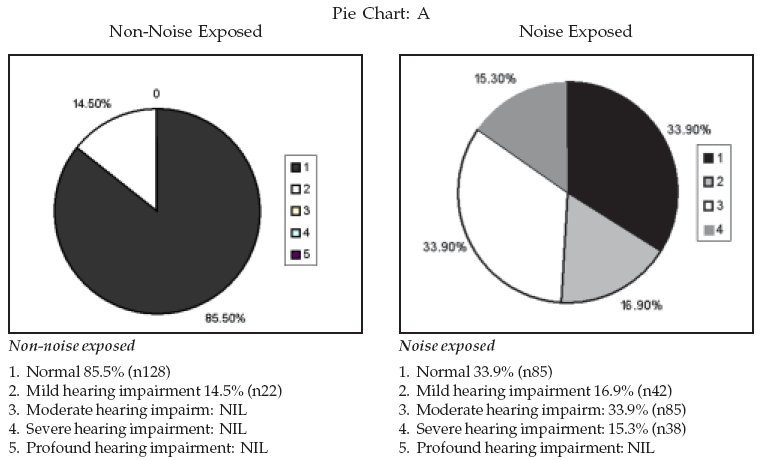
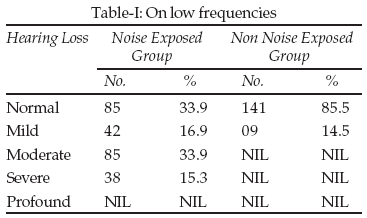
Results were further analyzed on low frequencies i.e. 0.5, 1.0 and 2 KHz (shown in Table-I and Pie Chart–A) and on high frequencies i.e. 03, 04 and 06 KHz (shown in Table-II and Pie Chart-B).
These results shown at 1000 frequency a total of 65.1% (n165) of subjects of noise exposed group suffering from mild, moderate, severe and profound hearing loss of while 85.5% (n141) of non noise exposed group are normal and only 14.5% (n09) have mild hearing loss. At high frequencies 13.6% (n34) showed normal but 86.4% (n216) were found with mild, moderate, severe and profound hearing loss in noise exposed group. 94.3% (n141) were normal and 5.7% (n09) with mild hearing loss in non noise exposed group. Minimum duration to noise exposure was three years and maximum 32 years round the clock i.e. 24 hours. Mean noise exposure time came up 15.9 years. It was also noted during the study that these aviation workers hardly carry any sense of awareness towards the problem.
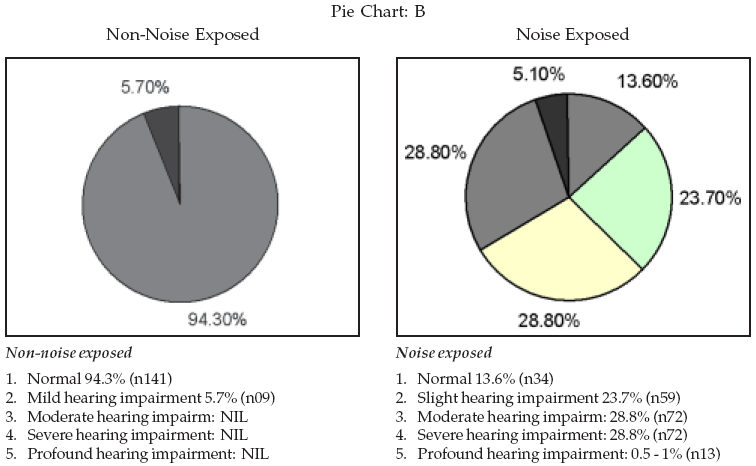
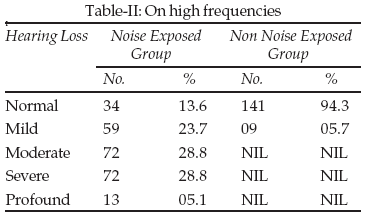
More over 05.1% (n13) subjects were noted with profound hearing loss at high frequency in these aviation workers, which has not yet been reported in literature. The ages of all these subjects were from 47 to 53 years.
DISCUSSION
Exposure to sound produces efforts, which has been recognized for centuries but generally ignored until some time of the industrial revolution when it was fully reckoned.
8 In Pakistan work on noise induced hearing loss is very little as no study exists on aviation noise. No study exists yet in literature where aviation workers are exposed to a noise level of 110dB or above round the clock, for a minimum noise exposed period of three years and maximum 32 years with a mean 15.96 years.However a study
9 on airport employees in available in literature. In this study subjects were exposed to aviation noise round the clock. The prevalence of high frequency loss in all employees in this study is 41.9% but in our study it is 86.4%, which is more than double which, indicates that exposure time and higher level of noise (110dB) is the cause of this high percentage of effected subjects. More over 05.1% (n13) of subjects are found to have profound hearing loss. Though this study is similar to ours, with a difference that there is no matching variable of non-noise exposed group of age. This ultimately strengthens our results.A recent study
10 has also mentioned the relationship between NIHL and age. It was found that elderly subjects were more susceptible to NIHL than younger subjects. It has now been evolved that no other study has yet been done before. The degree of auditory damage is highest yet reported.The variable, sex the most important predictor was not considered in our study as all the subjects were male both in noise exposed and non-noise exposed groups. Noise has become a concern for the industrialized world; it is yet to be fully reckoned in Pakistan.
11 We do have some more problems such as:* Lack of education and awareness about noise pollution.
* Non existence of pre employment Audiological assessments in majority of organizations. However routine medical check up is mandatory for public sector and some private sector organizations but it does not include Audiological assessments.
* Poor usage of hearing protection devices (HPD’s).
* Non existence of hearing conservation programmes for industrial workers in particular aviation workers.
* No regulatory law yet exists. World health organization (WHO) and International Labor Organization (ILO) have set industrial standards for noise level. The current standard limits the noise exposure to 85dB for 8 hours and 95dB for two hours daily. But WHO and other noise regulatory organizations have yet to evaluate permissible noise exposure level to such aviation workers who are exposed round the clock.
Noise was identified as a commensurable disability by the United States courts in 1948 to 1959
12 and since then a very large sum is being paid in compensation but not in Pakistan. We feel that none of our research worker has really sincerely tried to establish the prevalence of sensory neural hearing loss in this country. Noise induced hearing loss do not take the first place when considered in terms of courses of sensory neural hearing loss. With out any doubt it appears second to chronic suppurative otitis media and congenital deafness in our society. Other main causes are presbycusis, Oto toxicity and meningitis and acquired post natal infections and traumas.The noise emission of aircraft is limited by International Civil Aviation Organization (ICAO) Annex 16, Chapter 2 and 3rd defining maximum permissible sound level limits under certain measuring procedures. While aircraft of older types which do not fulfill the ICAO requirements ("non certified aircraft’s") in Europe are not allowed to start any more and chapter two aircrafts are not registered anymore after 2002. Only chapter three aircrafts are allowed to operate.
13 But in Pakistan no regulation exists on the non-certified aircrafts. Hence noise level exceeds much to the permissible noise level leading to hearing impairment of aviation workers. It is recommended, to promote low noise aircrafts by setting noise related charges i.e. handling fee should be related to noise emission of aircraft. It is suggested that:
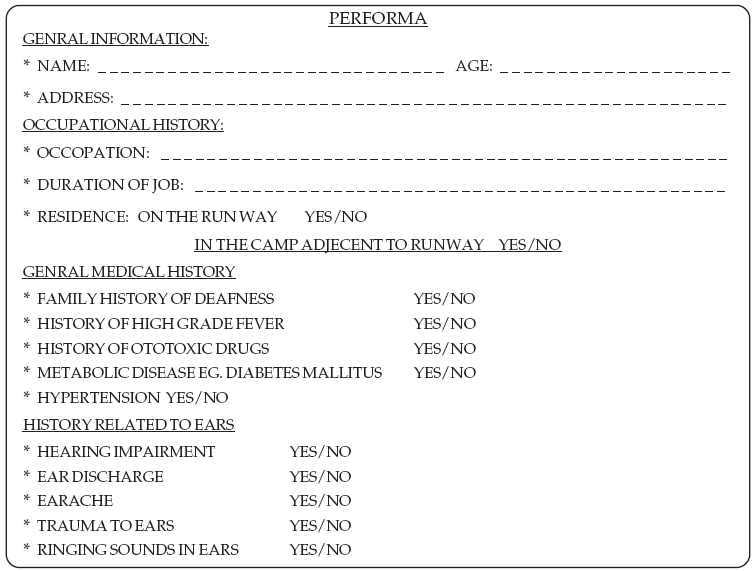
1. Periodical audiological assessment of these round the clock aviation noise exposed workers be carried out
2. Noise awareness to the exposed.
3. Use of hearing protection devices.
4. Legislation for NIHL.
5. Work place and residences be separated in terms of noise exposure i.e. residence away from noise zone.
REFERENCES
1. Alberti PW. Noise and the ear, Scott-Brown’s Otolaryngology Sixth ed. 1997;2:11-4.
2. Cudner YF, De Rotalier P, Albert C, Cohat JP, Ben Azzouz M, Buffe P. Fulguration d’oreille, Annales d’Oto-laryngologic 1986;103:343-9.
3. Flak SA. Patho Physiological responses of the auditory system to excessive sound: A Handbook of Physiology, edited by D. H. K. Lee. Chapter 2. Section 9. Reactions to environmental agents. Bethesda. Maryland: American Physiological Society 1977;17-30.
4. Spoendlin H. Histopathology of noise deafness. J Otolaryngol 1985;14:282-6.
5. Spoendlin H. Retrograde degeneration of the cochlear nerve. Acta Otolaryngologica 1975;79:266-75.
6. Fitzpatrick DT. An analysis of noise induced hearing loss in Army helicopter pilots, Aviation Space Environment Medicine 1988;59(10):937-41.
7. Proceedings of the international Symposium on Deafness and Hearing impairment in developing countries. Manchester, UK. 1995;24.
8. Fox Meyer S. Industrial noise exposure and hearing loss, Diseases of noise, throat & ear (John Jacob Ballenger), 12th edition, Lea & Febiger 1977;966.
9. Hong Os, Kim MJ. Factors associated with hearing among workers of the airline industry in Korea, ORL Head Neck Nurs 2001;19(1):7-13.
10. Troppila E, Pyyko I, Starck J. Age and noise induced hearing loss. Scand Audiol 2001;30(4):236-44.
11. Hasan S, Beg MHA. Noise induced hearing loss in industrial workers of Karachi. Pak J Otolaryngol 1994;10:200-5.
12. Caltin FL. 1986 Noise induced hearing loss, American J Otolaryngol 1986;7:141-9.
13. Lang J. Gerauschemission von Lastkraftwagen und Presonenkraftwagen auf Autobahnen unter tatsacheichen Einsatzbedingungen. Ost. Zeitschrift f. Verkehrswissenschaft Heft 2/1990 Wien, Austria.
HOME | SEARCH | CURRENT ISSUE | PAST ISSUES
Professional
Medical Publications
Room No. 522, 5th Floor, Panorama Centre
Building No. 2, P.O. Box 8766, Saddar, Karachi - Pakistan.
Phones : 5688791, 5689285 Fax : 5689860
pjms@pjms.com.pk